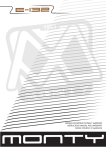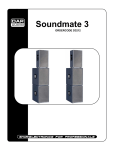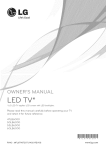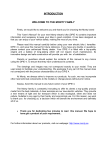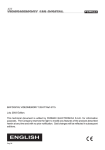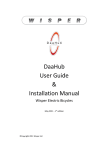Download USER`S MANUAL ELECTRIC TRICYCLE E-132
Transcript
USER’S MANUAL ELECTRIC TRICYCLE E-132 PRESENTATION WELCOME TO THE MONTY FAMILY We want to greet and give you our thanks for having chosen our Monty brand. This “Own manual” contains important and awful information to help you for a correct use of the new Monty electric Kit. It has been made in order that you can enjoy of the electric KIT with security and reliability, obtaining the maximum of its performance. Please read this manual thoughtfully before the first riding of the new vehicle fitted with electric KIT (From now on: KIT), and keep it for future references. In case of any doubt, call to your Monty dealer. The KIT is provided by an extraordinary engine of high quality and a long-lasting battery requiring no much maintenance. Its innovative design and safe construction is to provide you with Km and Km of riding satisfaction. The parents or tutors of young riders handling the KIT should be aware that they know the contains and understanding of this “Own manual”. The drawings and images of this manual may not correspond exactly to the required model. They are used solely to facilitate your understanding. We shall apologize to you if some parts of this manual do not correspond to the exact characteristics of your KIT. Due to the Desire of getting better and better our Monty products, they are constantly being improved. New technical improvements or different parts can be added to our models without previous notice to our customers. Please hand this Manual in case of any User changing. The manual must always be by the KIT. The Monty family is constantly improving in order to offer to our customers a product of the maximum quality with the best materials possible. A well clear example is the new Monty E-Bikes. A new means of enjoying transport: light, ecological, noiseless and without producing pollution. KIT suitable to any age by its easy handling. We want to thank you for having chosen this model which is to benefit the environment and in definitive to all of us.. Thanks a lot for your special attention on dedicating some minutes to read this “own manual”, and we expect to have got a product of your whole satisfaction. Please check the Monty web site for getting more information about our products. http://www.monty.es 2 GENERAL RULES • Please read this Manual thoughtfully before using the Monty KIT for the first time. • Ensure that the bike Works correctly before riding. • Not to change the technical characteristics of the KIT or to add anything which could interfere with them. • Safety equipment must be used. ATENTION: VERY IMPORTANT THE FACT OF NOT ACCOMPLISHING THE INDICATIONS OF THIS MANUAL MAY LEAD TO MECHANICAL FAILLURES, A LOSS OF CONTROL AND POSSIBLE FALLS, WITH OWN SERIOUS PHISICAL INJURIES OR OTHERS, INCLUDING EVEN THE DEATH. AN INCORRECT USAGE MAY ALSO RISK YOUR PHISICAL INTEGRITY AND THAT OF OTHERS. SAFETY WARNING NOT TO MANIPULATE EVEN NOT TO OPEN THE BATTERY, OTHERWISE THE WARANTEE SET IN THIS MANUAL IS NOT TO BE TAKEN INTO ACCOUNT. TO MANIPULATE OR TO OPEN THE BATTERY, CHARGER OR THE ELECTRIC PARTS CAN CAUSE ELECTRIC CHOCKS TO THEM AND EVEN BURN INJURIES IT IS ADVISABLE TO USE ALWAAYS THE PROTECTOR HELMET WARANTEE WARNING ANY MODIFICATION TO THE FRAME, FORK OR TO ANY OTHER COMPONENT OF THE KIT IS TO BE EXCLUDED AUTOMATICALLY FROM THE WARANTEE SINCE THE PRODUCT IS NOT TO BE ACCORDING THE MONTY SPECIFICATIONS. THE MANIPULATION OF THE ITEMS OF THE VEHICLE FROM THE SIDE OF THE USER IS TO EXEMP TO MONTY OF ANY RESPOSABILITY. EXCEPT IN THE VEHICLES WHERE A KIND OF MANIPULATION IS TO BE NECESSARY TOWARDS THE ASSEMBLING OR THE MAINTENANCE. IN CASE OF ANY DOUBTE, CONTACT WITH YOUR USUAL DEALER OR CHECK THE MONTY WEB SITE: http://www.monty.es 3 INDEX IDENTIFICATIÓN OF THE PARTS…..................................................................................6 UNDERSTANDING ICONS…..............................................................................................6 ELECTRICAL PARTS ASSEMBLING.....................................................................................................................1 1.1 WHEEL ASSEMBLING................................................................................................7 1.1.1 Front wheel removing……………..:...................................................................7 1.1.2 Tyre setting……………….:.................................................................................7 1.1.3 Assembling KIT wheel to the fork………….. .....................................................7 1.2 BRAKE ASSEMBLING / SHIFTING…….....................................................................8 1.2.1 Lever shifting …………………….........................................................................8 1.2.2 Brake levers & shifting grip…..…..……………....................................................8 1.3 ELECTRIC INSTALLATION........................................................................................9 1.3.1 Cables fitting…………........................................................................................9 1.4 CONNECTIONS..........................................................................................................9 1.4.1 Connections parts (Figure 12)…………............................................................10 2 USER’S GUIDE………...................................................................................................12 2.1 TYPE OF USE FOR WHICH THIS KIT HAS BEEN DESIGNED.............................12 2.2 KIT PERFORMANCE……........................................................................................12 3 BATTERY AND CHARGER……………………………....................................................14 3.1 BATTERY NIVEL INDICATOR.……......................................................................14 3.2 BATTERY CHARGING…..........................................................................................14 3.3 BATTERY FUSE………….........................................................................................16 II PART 4 VERIFICATIONS............................................................................................................17 4.1 VERIFY THE KIT BEFORE THE FIRST RIDING….................................................17 4.2 VERIFICATION POINTS……..................................................................................17 5 SECURITY….................................................................................................................18 5.1 CIRCULATION........................................................................................................18 5.2 NIGHT CIRCULATION…….....................................................................................18 6 ADVICES…...................................................................................................................19 6.1 GENERAL ADVICES……........................................................................................19 6.2 ADVICES TO IMPROVE THE KIT AUTONOMY.....................................................19 6.2.1 PRECAUTIONS TO TAKE INTO ACCOUNT…...................................................19 7 MECHANICAL PARTS AND MAINTENANCE….........................................................20 7.1 AJUSTMENTS.........................................................................................................20 7.1.1 REQUIRED TOOLS….……..................................................................................20 7.2 WHEELS..................................................................................................................20 4 PRESSURE CHART…...................................................................................................20 7.3 LUBRICATION AND CLEANING.............................................................................21 7.4 BRAKES WORK AND PERFORMANCE…..……………….....................................21 7.5 BRAKE CHECKING…..…..................................................................................22 7.5.1 RIM BRAKE SYSTEM………...........................................................................23 7.5.2 VERIFICATION................................................................................................23 7.6 AJUSTEMENT.....................................................................................................23 8 ELECTRONIC COMPONENTS......................................................................................25 8.1 CONTROLLER….......................................................................................................25 8.2 ENGINE......................................................................................................................25 KIT CHARACTERISTICS……..........................................................................................25 ELECTRIC SCHEME….....................................................................................................26 SOLUTION CHART………................................................................................................27 WARANTEE.......................................................................................................................29 FREQUENT QUESTIONS…..............................................................................................29 5 IDENTIFICATION OF THE PARTS VERIFICATIÓN: Open the KIT box by the cap of the superior part and verify that all the mentioned parts are being included. 1. 2. 3. 4. Lithium battery Left brake lever Charger Controller 5. Right brake lever 6. Speed control and contact key 7. Engine front wheel UNDERSTANDING ICONS The following icons are to be in order to understand easier this manual and to pay attention to the most important items. Go to the other point Caution Advice Maintenance 6 ELECTRICAL PARTS 1 ASSEMBLING The Kit assembling must be done in stable position and in horizontal way with some basic mechanic and electric knowledge. It is advisable to be assembled by an official mechanic. It is recommended to follow the bellow steps:: Wheel assembling, Brake / control assembling, Electric parts fitting, Connections 1.1 WHEEL ASSEMBLING 1.1.1 FRONT WHEEL REMOVING: Open the front brake in order that the tyre can pass and set it to the KIT wheel. Loosen the nuts of the front axle wheel (Figure1) and remove the wheel. 1.1.2 Tyre fitting: Remove the tyre from the wheel with the help of levers and set it to the KIT. (Figure 2). Verify if the tyre has sense of direction and fit it rightly. The engine cable gets out from the left side of the fork in marching order. Do not miss to set the band rim to protect the tube from the spokes. 1.1.3 KIT wheel assembling to the fork. Place the washer and nut enclosed to the right axle side of the wheel, fit the wheel to the fork with the engine cable getting out through the left side. Fit the washers between the fork and the engine, through the inside part of the fork tubes. (Figure 3). Tighten the left and right nuts with a fixed tool of 18 and 17 mm respectively. Figure 1 Figure 2 Figure 3 1.2 ASSEMBLING OF THE CONTROL COMPONENTS 1.2.1 BRAKE AND SHIFTING ASSEMBLING 7 First loose the nuts of the brake cables in order to take them out through the tensors. (Figure 4). Remove the brake levers and the shifting control. (Figure 5). Loose the brake levers with an Allen of 5mm. Loose the shifting control with a star screwdriver. Remove the levers together with the handlebar grips and the shifting control. Figure 4 Figure 5 1.2.2 Brake and control shifting assembling: Invert the shifting control and place it to the Leith side. Remove the brake levers for the ones provided with the KIT with the cable of disconnection. Place from inside to outsider by the left side of the handlebar: KIT left brake lever, shifting control, KIT grips. Place from inside to outside to the right side of the handlebar: Bell, KIT brake right lever and the throttle with the KIT contact key. Adjust them to a handy position and fix the following parts by the following stools: - Brake levers (Allen 5 mm.) - Shifting (Star tool) - Throttle (Allen 3 mm.). Figure 6 Figure 7 Ensure the brakes to work properly. And the cables well fixed with their respective clamps. Check the brake mechanical and maintenance section. 1.3 ELECTRIC PARTS ASSEMBLING 1.3.1 Cable sitting/fitting: 8 Fit the brake /speed control electric cables in a parallel position to the brake cables. Envelope the cables with a spiral band for a correct fixing.(Figure8). The cables must be set along the frame in a smooth way (Figure 9) to the rear battery bag where all the connections must be connected Figure 10). The cables must be set with the right strain: Avoiding the cables to be folded and at the same time to let them enough loose towards the good handlebar performance. The engine cable must be guided through the fork side at the head set high of the rest of the cables. Make sure that the tricycle can turn to both sides without any problem. The cables must be fixed well to the frame with the clamps, no ends to be let or anything which can cause any hooking. Figure 8 Figure 9 Figurae10 1.4 CONNECTIONS Make the electric connections with the clean and dry hands. Check the electric scheme and respective figures. In case of any doubt, call at the customer service number. Once the battery bag has been set to the rear tyre basket of the tricycle with the Monty brand looping backwards and the cables well guided and fastened, one must check the length of them to be right to make the respective connections. It is possible that the engine cable shall be connected to the electric connection out of the battery bag. It is recommended to realize the entry of the cables to the battery bag through the left side since it is where the controller is set and easy to be reached by only open a little the zipper. The controller, an aluminium box where all the cables are being set, is already connected at factory through the negative cable to the battery. (Figure 11, Blue circle) One will have to connect the key contact + speed control (throttle) + the brake/engine levers. 1.4.1 Connection parts (Figure 12): Contact key + throttle: 9 There are two tubes getting out from the throttle composed by three wires / White, Black and Red). The three must be connected to the controller through a connecting link with three wires (Yellow, Black and White) The thin cable corresponds to the throttle, composed by three wires (White, Black and Red) and they must be connected to the controller by a connector with three wires ( Yellow, Black and White) respectively. The big one belongs to the contact key, composed by two wires (Red and Black): The red must be connected to the red one of the battery (positive) and the Black one to the Black cable of the controller. (Figure 11, clausor). Brake levers: From each brake lever is getting out a cable with two wires Red and Blue) to be connected to the controller by a link with two wires (Black and Blue). There are two connectors alike, one for each lever. Connect both levers to them, no matter the order. Engine: The engine connection to the controller is being made by a sole tube. The fitting shall be in a way that the flange of both items is let closed. The connection of the charger to the battery must only be made when the battery is going to be charged. Check the battery charging section. Once all the connections are being set, verify the performance of the KIT. Turn the contact key to clockwise and the lights of the battery level must be shown. Turn the throttle and the front wheel is to work. Make a first try in a secure and free place. The KIT can go forward some m. before one can control it. Figure 11 Important: keep the battery by the frame firmly in order not to be removed by uneven terrains. Not to place anything over the battery. 2 USER’S GUIDE 2.1 TYPE OF USE FOR WHICH THIS BIKE HAS BEEN DESIGNED 10 This KIT has been designed as a complement to our Monty tricycle, providing a help to the Vehicle to perform trips with a minimum effort. It is made to be adapted to the Monty tricycle in a very easy way. ás. The Monty electric bicycles and their components are being designed as for a normal bicycle to be used along the standard routes in good state and in good conditions. Incorrect usage other than the above mentioned or cross-country riding should be avoided. Ride only along the allowed routes set by the local indications. ATENTTION: IMPORTANT This KIT is not to be recommended for kids under the 12 years old. This KIT is not to be recommended for persons with a superior weight of the 100 kg. This Kit is made for a non-professional use. Figure 13 Figure 14 2.2 KIT PERFORMANCE The electric bicycle or tricycle fitted with the KIT: MONTY E-132 has a simple performance. It is the same as riding a conventional bicycle but with the help of an engine, as an electric bicycle. Steps for a right using: (First the KIT must be assembled on the whole) 1º Electric connection system: Turn the contact key a quart to clockwise (Figure 16), the leads from the chart of the handlebar are to be shown indicating the battery charge level. (Figure15). 11 Figure 15 Figure 16 See: Battery and charger. 2º To initiate the first riding of the vehicle: One shall Poly press the speed grip (throttle) to go forwards and the engine is to work automatically. One can regulate the engine speed by the throttle, more you turn the grip, the quicker the engine is to go, till a maximum speed of 23 km/h. 3º Gears shifting One shall be used to the changing of the gears: The short ones (1,2,3) to begin the riding and for the pendent roads and the long ones (4,5,6) for quick riding and even roads. The pedal help is to improve the performance on the whole system and the lasting of the battery. See section: general advises and gear changing 4º How to stop and decrease the speed: Press the brake lever to stop the KIT, automatically the assisting engine is to stop as well. See section: General brake advises IMPORTANT: ON PRESSING THE BRAKE LEVERS, THE EELCTRIC SYSTEM IS TO STOP THE ENGINE PERFORMANCE AUTOMATICALLY. IMPORTANT: BEFORE RIDING THE KIT, READ THE FOLLOWING SECTIONS:“VERIFICATIONS BEFORE RIDING “ AND “SAFET RIDING” 3 BATTERY AND CHARGER The battery is one of the most important items of the KIT. A correct use of the battery is to determine its life. The battery must be complete charged before riding the KIT. The indicator is to show you when the battery has been charged. Make sure the battery to be fixed to the frame. 12 The KIT is provided with a Lithium battery of 36V-9Ah The lithium battery provided by the KIT 302 does mot need a precise maintenance but yes advisable stops to follow: It must be charged before any riding. Even stored, the battery must be checked Avoid the battery to be discharged on the whole. The batteries can be discharged even if they are not to be used. So it is normal that you can find the battery down alter a long time of being stored and even if you let the battery charged on the whole. 3.1 BATTERY CHARGER INDICATORS. The throttle on the handlebar is provided with a battery charge indicator, Figure (13). If the right Red Light is shown while one is riding the KIT, it would mean that the battery capacity is run out, in this case, it should be charged at once. It is normal the battery to get down on the beginning or getting on a pendent. The indicator is more reliable riding on even roads. Figure 17 3.2 BATTERY CHARGE The battery must be charged on the whole before the first riding. When you receive the KIT, the battery can be the 50% of its charge. Use only the charger provided with the KIT, using other chargers, one could deteriorate the battery. Keep the battery far from the water in order to avoid shocks. The charger should only be made in covered places. The charge of the battery will depend of the discharge which had had. And it can last 5 hours. The charger is to indicate when the battery is already charged. Important: To charge the battery one must connect to the 220 G from the general net, once the charger and battery had been connected between them. And in order to disconnect the same but vice versa. Steps to follow: 13 1. Remove the charger from the battery bag to get the battery enough ventilation. Check the charge voltage to be the same than the fuse of the net system (220v). The charger specifications are impressed on them. 2. First connect the charger cable (B) to the battery connector (A), Figure (18). Make sure to be well fixed). 3. Second connect the plug of the charger to the socket of the net system 4. To disconnect the whole system: First disconnect the battery from the net system and later the battery. Figure 18 Indicator of the level charge. When the battery is being charged, the red light is being shown. (Figure 20) When the battery is already charged on the whole, the Green Light is being shown. (Figure 21) Very important: Do not allow children to charge the battery by themselves. The electric charge net (220v), can cause personal serious injuries even death. Do not charge the battery barefoot on a damp or wet floor or in conditions which threaten the one personal safety. The sock of the electric system must meet the pertinent safety conditions. 3.3 BATTERY FUSE The battery is provided with a fuse of 20ª to avoid of any possible shocks. The fuse is set inside of the battery. In order to check the fuse, it is necessary to remove the cover by turning the thread. The process charge must not last more than 8 hours. 14 If the KIT is not to be used for a long time, the battery should be let charged the 50 % of its capacity and to make a maintenance charge one time per month. Use always the charger provided with the KIT. The battery charge is to depend on the consume which had had. It can last 5 hours. The charger is to advise you when the battery is charged. The batteries are sensitive to extreme temperatures, in general, the battery performs well in high temperatures. When the temperatures reach under the 0 Cº, its performance can go down a third part of its capacity. In winter the distance rate can be inferior and in temperatures of 20 Cº, its capacity is to be normal. When the temperatures are superior than the 35º-40º (to be exposed to the sun for a long time), the electric components can perform in no a right way. Actions which may effect or reduce the battery performance. Start and stop the KIT constantly as it can be riding in the city. Brake, start and stop the KIT constantly. Ride upwind or uphill and bearing extra weight. Low tyre pressure and braked wheels. The above actions mentioned can influence on the battery performance, reducing its life and the rate to be travelled being shorter. It is recommended to take well note of them to extend as much possible the travel distance of the KIT. One shall calculate the distance to travel before going on. In general the batteries are sensitive to extreme temperatures The battery charging must be done in a dry and well-ventilated area. II PARTE 4 VERIFICATIONS 4.1 VERIFYCATIONS BEFORE USING THE KIT FOR THE FIRST TIME: • Correct performance of the two brakes: Front and rear. • Correct pressure wheels. • Correct tighten of the pedals. • Correct tighten of the wheels nuts. • Correct checking of the folding system. 15 • Correct tighten of the quick releases. Takes note as normal the following points mentioned below before using the KIT. 4.2 VERIFICATION POINTS: WHEELS The tires and the rims are important parts for the right performance of the KIT. 302. Check the correct pressure of the tires and the run out of them and the estate of the rims. Make sure the wheels to be well fixed and placed by their fix system. Avoid water enter into the bearings. HANDLEBAR AND STEM The handlebar and the stem must be fixed in a comfortable and secure position for the user. The position of the handlebar must be according to the rider. Verify the handlebar to be well fixed and placed to its position. Never overpass the minimum allowed indicated stem insertion. HEAD SET AND FORK The head set must be checked to turn to both sides free and the whole head set system not to have play. If the fork is of the suspension kind check everything to be right. BRAKES Make sure the brakes to work properly. The brakes must perform and allow to stop the KIT at a secure distance. On pushing any brake lever, the engine must be disconnected. Check the run out of the brake shoes or pads. TRANSMITION The KIT transmition must be verified in order to work well. It must be kept clean and lubricated. Not to make strange noises and the changes must be made in a smooth way and exactly. A good regulation is essential in order to get a good performance of the KIT. 5 SECURITY 5.1 CIRCULATION Attention to the road When one is riding must be aware of anything which may pass: Avoid any potholes, the grids of the drains or edges which could make the wheels to skid. Attention with the turns, mainly riding the tricycle if you are not sure get off. Take care with the wet conditions In wet conditions, the brake system needs to perform stronger than in normal situations and it shall be calculate more distance for braking. The rain reduces the visibility and the grip of the wheels as well. Use the low gears on the turns, on the zebra pass or sleepy areas in rain and wet conditions. Use the brakes with precaution 16 Keep a moderate distance with the other vehicles and other objects. Calculate the brake capacity with respect to the distance. Adjust the distance braking capacity. To stop the KIT, grip both levers at the same time. The excessive use of the front wheel can provoke a skid on the front wheel, even the rear wheel may lost contact with the ground. Take into account that the tricycles fitted with the KIT needs to calculate the brake distance in advance. THE CORRECT PERFORMANCE OF THE BRAKES IS VERY IMPORTANT FOR ONE SECURITY AND OF THE OTHERS. VERIFY THE BRAKES BEFORE ANY RIDING AND DO NOT USE IT IN CASE OF NOTICING SOMETHING FAULT. 5.2 NIGHT RIDING Take care with poor luminosity Be prudent on riding with poor Light. The KIT is provided with a light and reflector set. Keep them well clean and in the right position. Thought the reflectors are items to be seen, they do not light up. Use a front light and rear one under poor conditions. It is convenient to bring striking and reflecting clothing, especially during the night. 6 ADVICES 6.1GENERAL ADVICES: Take care on overtaking cars or other vehicles Do not make insecure actions while riding Respect and be aware of the circulation rules The local illumination rules must be known Protect the KIT from the thieves The KIT should be registered in the local police Provide your KIT with a lock No person to be brought at the rear carrier Use and set the right gears Bring a toll for everything and a fist-aid kit Use always the Helmet protector 6.2 ADVISES TO IMPROVE THE AUTONOMY Set the gears 1 and 2 to start and help the engine by pedalling. Help the engine by pedalling on the pending roads. 17 Do not use the speed grip constantly Keep the tires pressure to be right Verify the rakes not to touch the rims. Keep a media speed if it is possible. When the KIT had to be stopped, use the brakes in a carefully way, letting the KIT losing speed by itself. Do no to over pass the allowed weigh If the system lights provided with the KIT is supplied by the battery, use them only in necessary moments. 6.2.1 Preventive measures on using the KIT. 1. In order to brake or to stop the KIT, the user will have to press both brake levers, depending on the circumstances, the engine is to be disconnected automatically. To take into account the brake lever system: Same system like the bicycle: The left brake lever brakes the front wheel and the right lever brakes the rear wheel. 2. This KIT is only to be used by one sole person. 3. Reduce the speed on rainy days in order to avoid any accident. 4. Avoid using the KIT in bad days: Rain and snow. ATTENTION: The brake lever position can be inverted in some countries. The autonomy and performance of the KIT depend on different factors: These can be classified in two types: External factors: The usual from the environment conditions (surface, climate, etc). Internal factors: They are the ones corresponding to the bicycles state, riding style.. The external factors little can it be done. The internal factors: They can be improved depending on the use and maintenance of the KIT. It is possible to last the life of the battery and the run out of the components. Use the gears 3 or 4 in an even surface an Light pending. Use the gears 5 and 6 in Haig speed and in descent. In order to chain the gears, get down the pedal force, press the shifting and go pedalling. The gears must be changed one by one. Use the gears 1 and 2 to stop the KIT. Note: Not to change the gears while the KIT is stopped and the gears must be changed one by one. 18 ATENTION: As any mechanical device, the KIT is to wear down along the time. The different materials and components used react differently to this daily decline. If the lasting of any item has been finished it can be broken, causing injuries to the user. The cracks, scratches or discoloration of the items can be a signal of intense use, therefore they should be changed. 7 MECHANICS POINTS AND MAINTENANCE 7.1 AJUSTMENTS 7.1.1 REQUIRED TOOLS It is recommended to be provided with the standard tools to repair the KIT. The majority of the suggestions and advises can be made with standard tools. However, sometimes, it is advised to go to the official distributor for special adjustments. Usual tools: - Star and plane screwdriver - Allen tools (3, 4, 5, 6 mm) - Fixed tools. (8-9,10-11,14-15,18-19mm) - Pincers Caution: A wheel in poor conditions may cause the user lost the control and possible falls. Check the wheels each time before riding and do not use the KIT if one has detected a problem. 7.2 WHEELS TIRES The tires must be in good state and the thread not to be cracked or either to be run out. They must keep the grip as the first day of riding. The size of the tires is being indicated 19 on them. On changing the tires, make sure them to have the right size to the rim and the Vehicle type. CAUTION: On replacing the tyre, make sure to have taken a tyre compatible with the rim and type for the KIT. The KITS tires have special characteristics different from standard ones. Tyre pressure Tires must be inflated to the right pressure to ensure the KIT to work properly. That is to say:: - With a high pressure, it is to be achieved a greater speed, though, the riding is to be less comfortable to the user and the risk of falling on curves or slippery surfaces. - With a media pressure greater comfort is to be achieved. The valve is like the “American” type as the ones used by the cars. However, it should be avoided filling the tires at the petrol stations, etc. Use a pump with suitable nozzle to the valve. To inflate the tyre, remove the valve cap and place the nozzle on the valve, ensuring air not to be gone out. Check the pressure and place the valve cap to keep it from getting dirty. In case the tubes got flat, it is advisable to change them, instead of being repaired. Remind: The maximum tyre pressure allowed is set at the edges of the tires Before using the KIT, the tire pressure should be checked ( inflate the tires without exceeding the limit printed on the lateral sides of the tires), the tires wear, their fitting and the alignment to the rims. PRESSURE CHART Wheel Maximum pressure Front Rear Bar 3,5 3,5 KPa 350 350 PSI 50 50 Recommended pressure Bar KPa PSI 2,0 200 29 2,0 200 29 EQUIVALENCE (Aprox.): 1 Bar = 100 KPa = 14,5 PSI CAUTION: The excessive run out of the tires can cause a faulty tyre fitting provoking injuries to the user. Do not use rims shown a clear run out. 7.3 LUBRICATION AND CLEANING 20 Clean and lubricate the chain and sprockets once a month. Avoid excess grease falling on the rest of the KIT by placing a rag behind the chain. Once the chain has been lubricated, wipe off any excess grease with a rag. Do not use gasoline to clean the sprockets as if it is highly inflammable and can let a thin film of grease on evaporating. Use a degreasing liquid and brush the sprockets to be clean. The pedal bearing must be cleaned one time per year. 7.4 BRAKE DJUSTMENT AND WORKING The KIT engine is being stopped by the brake levers. That is to say, on pressing the brake levers, the engine is stopped. CAUTION: As any braking system, an incorrect adjustment, poor maintenance or a bad use of the brakes may cause the lost control of the KIT with all the consequences that this may bear. Never use the KIT if the braking system is not working correctly or if you suspect any type of problem either with the brakes or to the cables. If the KIT does not work properly, fix it or take it to an authorized dealer. Adjusting the braking system is difficult if one does not have the necessary know-how, experience and material. It is strongly recommended to make the brake adjustments by an authorized dealer. No all the levers are suitable to the brakes. Use only levers suitable to the brake fitted to the KIT as it can be the original levers. 7.5 BRAKE ADJUSTMENT 7.5.1 Rim brake system In this type of brakes, the levers are connected by means of cables. Pressing the brake levers, the brake shoes/pads perform over the rims braking the wheels.. The rim brake system is formed by the following components: - Rim - Brake levers - Brake cables and casings - Brake shoes /pads Never use this type of brake on rims designed for disc brake. The brake rim requires a flat surface for the brake shoes to work properly. 7.5.2 Verification Before using the KIT, press the brake lever hard. The lever should never touch the handlebar. If it does so, the cable length will have to be adjusted as it is mentioned forwards. When the brake levers are not being pressed, the distance between the brake shoes and the rim should be a 1-2mm. The brakes shoes must be aligned with the rim surface. Check the brakes shoes before using the KIT, they must be fixed and aligned to the rims. The alignment of the brakes shoes is important in order to avoid producing noise. The Vbrakes can not need the requirement checking. 21 Check the brake shoes state one time per month. The brake shoes may have groves on their surfaces, if any of them are less than 2mm deep, they will have to be changed and 1mm in the V-brakes system. In the case that the brake shoes had not grooves, they will have to be replaced when they were only 3mm left of the rubber block. Setting the brake shoes vertically should be such that the rim’s edge were of 1mm by over the brake shoes extreme. The brake shoes have to make contact with the rim perpendicularly to the brake surface as being shown. Figure 17 The brake shoes must also be placed a little inclined to the wheel direction in order to avoid the brake to be less effective and consequently noise. Figure 18 Check the cables one time per month to ensure them to be right and the casings as well. Remove any defective cable or casing. The brake levers and the brake shoes should be fixed every three months. Attention with the V-brake bolt. - Brake shoes fitting: 8-10Nm - Brake fixing: 8-10Nm - Brake lever clamp 6-8Nm Figure 17 Figure 18 Figure 19 7.6 AJUSTMENT HOW TO ADJUST THE DISTANCE BETWEEN THE BRAKE SHOES AND THE RIM To increase the distance between the rim and the brake shoes, turn the screw clockwise (Figure 20) and to reduce the distance the inverse. In case it could not be done as it is above mentioned, loosen the cable bolt clamp and reattach the cable. Figure 20 HOW TO ADJUST THE DISTANCE BETWEEN THE BRAKE SHOES AND THE ALIGNMENT Loose the brake shoes bolt fixing. Follow the instructions in order to check the brake alignment and fixing. Later, fix the levers as maximum as it is possible: 10 times. Make sure the cables to be well fixed, the brake shoes well placed with respect to the rim and the tires without touching the brakes shoes. 22 HOW TO REMOVE THE WHEELS V-BRAKES type: The connection tube should be disconnected. Press with a hand the brake shoes against the rim and with the other hand, pull the tube backwards from the connecting point and get up the tube. Once disconnected, on getting out the brakes shoes, the tube is to get out as well. In order to close the brakes, one must follow the inverse. LUBRICATION The pivots of the brakes should be lubricated every three months with synthetic lubrication, the same as for the chains. On fitting a new cable, this should be lubricated a little. Important: The left brake lever corresponds to the front wheel and the right brake lever to the rear wheel. To get the KIT stopped, press both brake levers. 8 ELECTRONICS COMPONENTS 8.1 CONTROLLER The KIT controller is the essential part of the whole system. It is a small box situated under the battery. All the connections from all the elements are connected in this box. It is the item which makes the KIT to work properly since it receives all the information given from the brakes, pedal sensor (pedalling turn and force), engine, battery etc. The controller makes the engine work well and ensure the security of the KIT. Su comprobación y manipulación requiere herramientas y conocimientos específicos que debe realizar el distribuidor autorizado o la fabrica Monty. 8.2 ENGINE The KIT is provided with a top-quality and resistant engine. The KIT engine form part of the front wheel, designed to provide the maximum service with barely any required maintenance. The engine as part of the front wheel must be well fixed as it is explained in the wheels section. Otherwise, there is risk of a serious problem. Take special attention with the cable getting out from the axle, avoid touching it. Important: Avoid heavy hits or damages to the wheels, the engine could be broken down as well. IT is recommended to verify the KIT one time per year to ensure its performance to be correctly. 23 KIT CHARACTERISTICS Model Battery Voltage Capacity Range (years) Nº Charges Charging time Leed charger Weigh Engine Type Fork width Cable side KIT TRICYCLE Lithium 36 V. 9 Ah. 1-2 300 Aprox. 4-6 hours 220 V 3 Kg 250W Brushless 100 mm Left Importance of the use of original parts It is extremely important to use always original parts when replacing the KIT components. Not doing so, it may invalidate the manufacture’s warranty. 24 25 SOLUTIONS CHART: INCIDENCE After setting the battery to be charged, there is not indication of being charged. ON POSSIBLE CAUSE 1. The battery may be discharged on the whole. 2. The fuse is out or order 3. The key switch does not work. 4. The battery is not well placed The engine is stopped 1. The battery may have all at once been disconnected. 2. The fuse is out of order. 3. It may be a faulty electric problem 4.A brake lever must be pressed SOLUTION 1. Charge the battery. 2. Change the fuse. 3. Call the technical service. 4. Verify the battery to be well placed and to have contact. 1. Verify all the connections and connect again. 2. Check the fuse and change it if were necessary. 3. Check it with the technical service. 4. Verify the brake levers not to be pressed. 26 WARANTEE A warrantee is being established through the vendor in accordance with the law /2003, dated July 10, on the consumer sales warranties, according to the Directive normative 1999/44CE. Additional conditions: The warrantee does not cover the KIT parts subjected to normal run out use such as tires, chain, brakes, cables etc. The battery and charger are being covered by a warrantee as follow: Lead-Acid battery: 6 months and the lithium one: 1 year. Never use any other manufacturer’s components. Never repair the KIT by oneself. Take it to the store where the KIT was purchased or to an authorized Monty agent. In case of not following the just before mentioned instructions, Monty is not to assume any responsibility in case of any accident and consequently the warrantee is not to be any value. Modifying the frame, fork or any component implies that the KIT is not longer corresponding to the Monty specifications, consequently the warrantee is being cancelled. The number of the frame is set on the head set tube. 27 FRECUENT QUESTIONS Can one use the KIT without the battery? Yes, no problem, however, if you remove the battery, the lights are not to work. Where is the identification frame number? It is engraved underneath of the headset tube. It begins with the model number, for example 301xxx In what direction the pedals must be thread? (See the required section) - To assemble them: They must be fixed on the same direction that the wheels turn when riding: the right pedal clockwise and the left one counter-clockwise - Remove the pedals: The same way but in the opposite one. Can one wash the KIT with water? Yes, but paying attention with the electric connections. Not to use the press water system. Can one use the KIT under the rain? Yes, if it is a normal rain Can the KIT be stored in a place not covered? It is recommended to protect the KIT in a covered area, especially by the areas by the sea. What happens when the KIT has not been used for a long time? The battery must be charged even it is not used. A kind of maintenance must be made, even if the KIT is stored for a long time. MONTY OFFICIAL DISTRIBUTORS AND OTHER CONTACTS It is recommended to get in touch with the dealer where you bought the KIT, in case of any problem or doubt. More information can be found on the Monty web site: www.monty.es or the phone N: 93.632.59.89 or by e-mail [email protected] BICICLETAS MONTY, S.A. DPTO. E-BIKE C/ INDUSTRIA, 30-32 08970 SANT FELIU DE LLOBREGAT BARCELONA – SPAIN – Last printing:: Marzo 2009, Ref: MU KT20 V/0903 28




























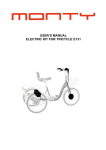
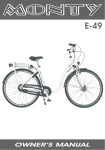
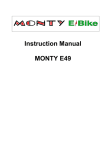

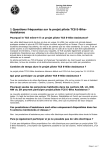
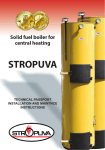
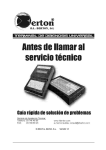

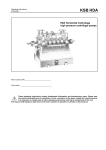


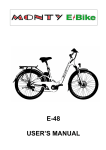
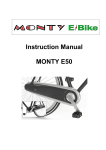
![[PF03] User manual for WHITE-COLOR DOT - Auto](http://vs1.manualzilla.com/store/data/006282387_1-d7d2ed898b52dfe4f67339814a689f58-150x150.png)

